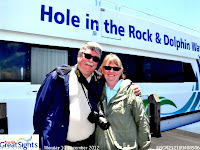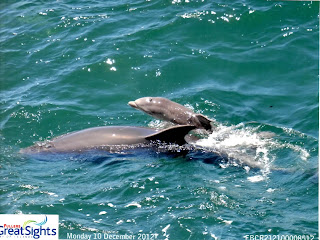North to the Bay of Islands
 |
| Bottlenose Dolphin in the Bay of Islands |
 |
| Waitangi Treaty Grounds |
Our last bus tour took us out of Auckland to the north, to where the guide claimed "that New Zealand really started", the Bay of Islands. This area was occupied by whalers and loggers in the early 19th century. The area was a "wild west". No law and few rules. The problems got so bad that the Maori leaders were motivated to sign a treaty with the British to have them impose law and order in the area. Unfortunately, the Maori version of the treaty and the English version have quite different interpretations, a source of ongoing conflict right up to present day. Sounds very familiar to someone from Canada. I'd say first nations relations are quite similar, and for similar reasons. Land confiscated with little or no compensation is hard to overcome.
 |
| Frank hugs the Kauri Tree |
On the way north, we stopped for tea at a roadside cafe, and for a view of an 800 year old McKinney Kauri Tree. These trees were quite common in the 19th century, but have been mostly logged out of existence. They grow so slowly. It will take a long time for them to come back, even with our help. Makes me want to be a "tree hugger" :-)
 |
| Maori Meeting House at Waitangi |
|
 |
| Interior of the Meeting House |
|
 |
| Our Waitangi Guide explains the Treaty |
 |
| Sundial in the Busby House Garden |
Due to problems with the pickup of participants and traffic out of Auckland, we were most of an hour behind schedule when we arrived in Paihia, so we went straight to the Waitangi Treaty Grounds. The bus drive turned us over to a lovely young lady who told us she could trace her lineage back to signatories of the treaty on both Maori and English sides. She took us to the Maori Meeting House and sang us a lovely Maori love song in greeting. Then she took us to the grounds where she explained briefly the nature of the Maori-English Treaty and the circumstances that brought it about. An English country house that also resides on the grounds. Once occupied by James Busby, British Resident in New Zealand, and family. It had a very beautiful garden. The house is now a museum, showcasing what life must have been like, and how the house was constructed from a kit-type approach, with all the joints numbered with Roman numerals.
 |
| Three of these trees make a Waka |
 |
| Waka |
Our guide then showed us the huge Maori Waka, or canoe, built to celebrate the centenary of the signing of the treaty in 1840. The canoe is a ceremonial war canoe that was built from three Kauri trees and takes 800 men to lift. They have built tracks to allow it to be launched with fewer men and avoid carrying it down to the water once a year for the ceremonies celebrating the treaty.
 |
| Russell Ferry Dock |
 |
| 20 knots across the Bay of Islands |
 |
| Us boarding the boat |
|

Back on the bus and down to the Paihia docks to catch the "Dolphin Explorer" for a cruise of the Bay of Islands. First stop Russell, the first capital of New Zealand, to pick up more passengers. Russell is on a peninsula, but is most often reached by ferry these days. We were fortunate to find a pod of bottlenose dolphins soon after leaving Russell. The pod included a very young one, just weeks old. There was a young photographer onboard who took our picture when we boarded. She got an excellent shot of the baby, which she gave us with the CD we purchased.
The weather could not have been nicer, light winds, perfect temperature, and not a cloud in the sky on our run out across the Bay of Islands to Hole in the Rock. Very relaxing. Nice end to our journey south of the equator and tomorrow is today.
 |
| Tall ship leaving port Russell |
 |
| Through the Hole in the Rock |
Yes, we did get to take the boat through the Hole. And visit the dolphin pod on the way back as well. We switched boats in order to make our bus back to Auckland. A tall ship was departing as we arrived back in Russell. I cannot image travelling to England in one of those, taking months to do so.
This tour was full of new and wonderful sights, but the 8 hours of bus riding was too much. I'd recommend doing what several of our fellow tourists did. Stay overnight, or more, in Piahia rather than go back to Auckland with the bus the same day.
